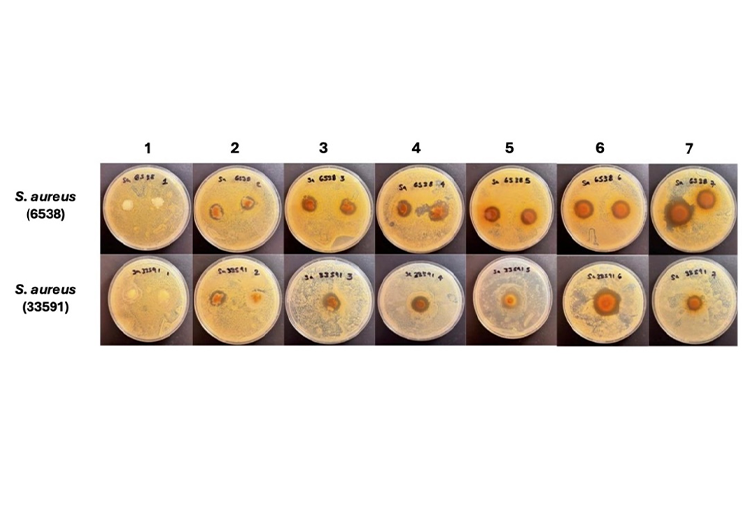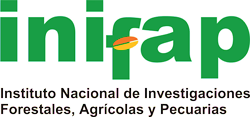Development of antibacterial talc from residual starch enriched with Larrea tridentata
DOI:
https://doi.org/10.29312/remexca.v16i30.4050Keywords:
Larrea tridentata, antibacterial talc, creosote bushAbstract
Larrea tridentata, commonly known as ‘gobernadora’ or ‘creosota’ (creosote bush), is an endemic plant of the Zygophyllaceae family that is very abundant in northern Mexico. Due to its toxicity, its derivatives have limited applications in materials with human contact; therefore, in search of new applications, the research was conducted in 2024. The work focused on carrying out a process to extract and process creosote bush and residual starch of potato from the southeast region of Coahuila, in northern Mexico, to obtain an antibacterial talc. The product obtained through a grinding and mixing process was characterized by infrared spectrometry and thermogravimetric analysis; a hemolysis test was performed to know its compatibility with human blood and its antibacterial properties were tested by antibiogram tests with Gram-positive strains of S. aureus (ATCC 6538 and ATCC 33591), obtaining a product with applications as antibacterial talc for its moisture-absorbing, antibacterial, and human erythrocyte-biocompatibility properties.
Downloads
References
ASTM F756-08. 2017. American society for testing and materials. Standard practice for assement of hemolytic properties of materials.
Bamidele, M. O.; Sandoval-Cortés, J.; Flores-López, M. L.; Pérez, O. B. Á.; González, M. L. C. and Aguilar, C. N. 2024. Bioactive compounds recover from Larrea tridentata by green ultrasound-assisted extraction. Phyton-International Journal of Experimental Botany. 93(11):3091-3107. https://doi.org/10.32604/phyton.2024.058422.
Casey, R.; Larkin, T. P. and ley, E. 2025. Ovarian Cancer and “Tainted Talc”: What Treating Physicians Need to Know.Missouri Medicine, 116(2): 83-86. PMID: 31040485.
Chaudhary, N.; Arif, M.; Shafi, S.; Kushwaha, S. P. and Soni, P. 2025. Emerging role of natural bioactive compounds in navigating the future of liver disease. In iLIVER. 4(1):100140. https://doi.org/10.1016/j.iliver.2024.100140.
García-Inzunza, R.; Valdez-Salas, B.; Schorr-Wiener, M.; Carrillo-Beltran, M.; Zlatev-Koytchev, R.; Stoytcheva-Stilianova, M.; Ramos-rigoyen, R.; Vargas-Osuna, L. y Terrazas-Gaynor, J. 2013. Aqueous extract of creosote bush (Larrea tridentata) leaves as green inhibitor for carbon steel in hydrochloric acid solution. International Journal of Electrochemical Science. 8(5): 6433-6448.
Hernández, E. A.; Arango, G. C.; Reyes, P. A.; Martínez, S. P.; Pita de la, P. C.; Macías, M. S.; Arias, P. A. and Breña, N. J. 2016. Water supply source evaluation in unmanaged aquifer recharge zones: The Mezquital Valley (México) case study. Water. 9(4):256-271.
Hernández-Zamudio, G.; Sáenz-Mata, J.; Moreno-Reséndez, A.; Castañeda-Gaytán, G.; Ogaz, A.; Carballar-Hernández, S. and Hernández-Cuevas, L. 2018. Temporal diversity dynamics of the arbuscular mycorrhizal fungi of Larrea tridentata (Sesse y Mocino ex DC) Coville in a semi-arid ecosystem. Revista Argentina de Microbiologia. 50(3):301-310. https://doi.org/10.1016/j.ram.2017.07.007.
Izquierdo, V. J. A.; Sánchez, G. M.; Peña, L. C. S.; Martínez, A. M. and Razo, L. M. 2022. Arsenic and fluoride in the drinking water in Tula City, México: challenges and lessons learned. Water Air Soil Pollut. 233(200):453-564. https://doi.org/10.1007/s11270-022-05674-x.
Jitsuno, M. and Mimaki, Y. 2010. Triterpene glycosides from the aerial parts of Larrea tridentata. Phytochemistry. 71(17–18):2157-2167. https://doi.org/10.1016/j.phytochem.2010.09.012.
Lambert, J. D.; Sang, S.; Dougherty, A.; Caldwell, C. G.; Meyers, R. O.; Dorr, R. T. and Timmermann, B. N. 2005. Cytotoxic lignans from Larrea tridentata. Phytochemistry. 66(7):811-815. https://doi.org/10.1016/j.phytochem.2005.02.007.
Lira-Saldívar, R. H. 2003. Estado actual del conocimiento sobre las propiedades biocidas de la gobernadora [Larrea tridentata (D. C.) Coville]. Revista Mexicana de Fitopatología. 21(2):214-222. http://www.redalyc.org/articulo.oa?id=61221217.
Martins, S.; Aguilar, C. N.; Teixeira, J. A. and Mussatto, S. I. 2012. Bioactive compounds (phytoestrogens) recover from Larrea tridentata leaves by solvents extraction. Separation and Purification Technology. 88(1):163-167. https://doi.org/10.1016/j.seppur.2011.12.020.
Martins, S.; Amorim, E. L. C.; Sobrinho, T. J. S. P.; Saraiva, A. M.; Pisciottano, M. N. C.; Aguilar, C. N.; Teixeira, J. A. and Mussatto, S. I. 2013. Antibacterial activity of crude methanolic extract and fractions obtained from Larrea tridentata leaves. Industrial Crops and Products. 41(1):306-311. https://doi.org/10.1016/j.indcrop.2012.04.037.
Núñez-Mojica, G.; Vázquez-Ramírez, A. L.; García, A.; Rivas-Galindo, V. M.; Garza-González, E.; González-Bravo, G. E.; Toscano, R. A.; Moo-Puc, R. E.; Villanueva-Toledo, J. R.; Marchand, P. and Camacho-Corona, M. R. 2021. New cyclolignans of Larrea tridentata and their antibacterial and cytotoxic activities. Phytochemistry Letters. 43(1):212-218. https://doi.org/10.1016/j.phytol.2021.04.013.
Osorio, E.; Flores, M.; Hernández, D.; Ventura, J.; Rodríguez, R. and Aguilar, C. N. 2010. Biological efficiency of polyphenolic extracts from pecan nuts shell (Carya Illinoensis), pomegranate husk (Punica granatum) and creosote bush leaves (Larrea tridentata Cov.) against plant pathogenic fungi. Industrial Crops and Products. 31(1):153-157. https://doi.org/10.1016/j.indcrop.2009.09.017.
Schmidt, T. J.; Rzeppa, S.; Kaiser, M. and Brun, R. 2012. Larrea tridentata - absolute configuration of its epoxylignans and investigations on its antiprotozoal activity. Phytochemistry Letters. 5(3):632-638. https://doi.org/10.1016/j.phytol.2012.06.011.
Sosa-Santillán, G. J.; Zugasti-Cruz, A.; Enríquez-Medrano, F. J.; Avérous, L.; Pollet, E.; Valdés-Ramos, K. G.; Gomez, C. G.; Romero, M. R.; García-Lobato, M. A.; Pérez-Aguilar, N. V. and Oyervides-Muñoz, E. 2022. Synthesis, characterization, and antibacterial activities of novel starch derivatives against E. coli and S. aureus. Starch/Staerke. 74(7-8):2100142 https://doi.org/10.1002/star.202100142.
Valdez-Valdés, M. F.; Enríquez-Medrano, F. J.; Zugasti-Cruz, A.; Sierra-Rivera, C. A.; Martínez-Mora, E. I.; Sosa-Santillán, G. J. and Oyervides-Muñoz, E. 2024. Preparation of a starch derivative bearing chloroaniline groups and the evaluation of its hemolytic, cytotoxic and antibacterial activities. Polymer International. 74(1):46-53. https://doi.org/10.1002/pi.6689.
Vassão, D. G.; Kim, S. J.; Milhollan, J. K.; Eichinger, D.; Davin, L. B. and Lewis, N. G. 2007. A pinoresinol-lariciresinol reductase homologue from the creosote bush (Larrea tridentata) catalyzes the efficient in vitro conversion of p-coumaryl/coniferyl alcohol esters into the allylphenols chavicol/eugenol, but not the propenylphenols p-anol/isoeugenol. Archives of Biochemistry and Biophysics. 465(1):209-218. https://doi.org/10.1016/j.abb.2007.06.002.

Published
How to Cite
Issue
Section
License
Copyright (c) 2025 Revista Mexicana de Ciencias Agrícolas

This work is licensed under a Creative Commons Attribution-NonCommercial 4.0 International License.
The authors who publish in Revista Mexicana de Ciencias Agrícolas accept the following conditions:
In accordance with copyright laws, Revista Mexicana de Ciencias Agrícolas recognizes and respects the authors’ moral right and ownership of property rights which will be transferred to the journal for dissemination in open access. Invariably, all the authors have to sign a letter of transfer of property rights and of originality of the article to Instituto Nacional de Investigaciones Forestales, Agrícolas y Pecuarias (INIFAP) [National Institute of Forestry, Agricultural and Livestock Research]. The author(s) must pay a fee for the reception of articles before proceeding to editorial review.
All the texts published by Revista Mexicana de Ciencias Agrícolas —with no exception— are distributed under a Creative Commons License Attribution-NonCommercial 4.0 International (CC BY-NC 4.0), which allows third parties to use the publication as long as the work’s authorship and its first publication in this journal are mentioned.
The author(s) can enter into independent and additional contractual agreements for the nonexclusive distribution of the version of the article published in Revista Mexicana de Ciencias Agrícolas (for example include it into an institutional repository or publish it in a book) as long as it is clearly and explicitly indicated that the work was published for the first time in Revista Mexicana de Ciencias Agrícolas.
For all the above, the authors shall send the Letter-transfer of Property Rights for the first publication duly filled in and signed by the author(s). This form must be sent as a PDF file to: revista_atm@yahoo.com.mx; cienciasagricola@inifap.gob.mx; remexca2017@gmail.
This work is licensed under a Creative Commons Attribution-Noncommercial 4.0 International license.


